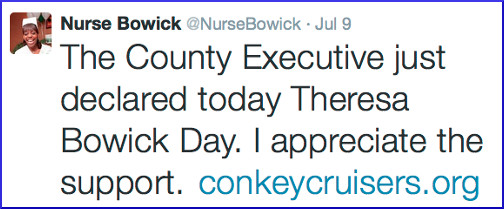Taxes, Bans and Ballots
Last year two California cities, San Francisco and Berkeley, had soda tax items on their ballots. The soda industry is said to have responded by investing $9 million in a campaign designed to stamp out any bad thoughts about their companies or products. Those elections attracted the attention of two experts, both from Cornell University, but with very different philosophies. In an essay issued by the university, their positions are described. David Just teaches food marketing and economics, and does not believe that soda taxes are effective against obesity. Also, like every other denier of a connection between sugary drinks and the obesity epidemic, he states that soda taxes penalize the poor more than the rich. When it comes to repeating the party line, Prof. Just can …
Childhood Obesity Awareness Month
One obstacle to activism is the human tendency to become fed up. A cause can raise awareness, then reach a point of diminishing returns and even develop an emotional backlash. People get compassion fatigue. More than five years ago, Neville Rigby wrote for The Guardian: We have obesity awareness with almost daily headlines, and continual debate, while the government’s Change4Life initiative is being promoted widely to the point where we need to take care to avoid message fatigue. That was the situation in the United Kingdom on the occasion of the first European Obesity Day, and 15 (mostly Eastern European) countries had signed up for active participation. Like many other nations, the UK strives to limit health care costs, ideally without reduction in the level or …
How One Man Lost 266 Pounds
Mark Manson is an author greatly interested in happiness, self-knowledge, habits, relationships, and several other areas of human awareness. He invited a guest blogger with a fascinating story, Kelvin Burnett, who lost 266 pounds by “getting his mind straight.” (A short time later, an expanded first-person account was published by Huffington Post as a reader success story.) As a child, Burnett had meningitis, which put him in a coma and damaged his hearing to the point of legal deafness. At around seven, he was enrolled in a school for deaf kids, and had already started to gain weight. By high school, obese was the only word that fit. Clothes didn’t, and he couldn’t shop for them in regular stores, or go on …
Highlights from “The Cost of Sugar Addiction”
A while back, Childhood Obesity News featured a four-part series about the many costs, both obvious and obscure, of sugar addiction. The toxicity of sugar is not a new concept. In the 1960s, Prof. John Yudkin sounded the alarm and was universally regarded as a crank. Health policy investigator Gary Taubes explains how the well-regarded Seven Countries Study was misinterpreted, and the harm that has resulted. In 1975, William Dufty’s book Sugar Blues had a significant impact on public consciousness. In 2005, the documentary film Big Sugar raised another assortment of issues. For instance: Daniel Stefik’s review of Big Sugar notes that the Fanjul brothers, Florida’s fabulously wealthy sugar barons, keep legislators happy by donating to both major political parties. In return, they enjoy yearly government …
Curbing Childhood Obesity with Legislation and Taxation
As 2014 drew toward its close, over half the American states had soda taxes. The city of Berkeley, California, became the first to successfully institute a tax on sugar-sweetened beverages (SSBs). Heartened by these advances, several other states were considering soda taxes of their own. One was Illinois, which, as Nathanael Johnson noted, was in severe budgetary trouble. Polling suggested that 65 percent of the state’s voters would support a soda tax that would make up for a $600 million Medicaid shortfall. The Illinois chapter of the American Academy of Pediatricians was in favor of legislation called the Healthy Eating and Active Living (HEAL) Act, whose history and current status can be found on an Illinois state website. For months, the bill has been painstakingly adding co-…
The Language of Obesity
Sadly, childhood obesity is inextricably connected with bias, stigma, discrimination, blaming, and shaming. “Obesophobia” is an actual word. It is an intense and abnormal fear of weight gain that might be caused by family influence or a distorted self-image that developed in some other way. Too often, the next step is anorexia or bulimia. Logically, it seems like there should also be an objective meaning, similar to “homophobia,” which is an intense fear of and aversion to homosexuals. But no, there is a different word for the fear of fat people: cacomorphobia, which in Greek means fear of an ugly shape. Fearof.net says: Cacomorphobes are terrified of fat or obese people; they simply cannot control the terror they experience around such individuals. They often …
Formerly Fat—Nurse Bowick of Rochester
This is not just any “formerly fat” narrative. Theresa Bowick of Rochester, New York, attended the Rochester Educational Opportunity Center (where she has subsequently returned to address the graduating class). After acquiring Licensed Practical Nurse credentials while working and raising a daughter, she went to community college for an associate degree in nursing. Then she graduated from SUNY Brockport with a bachelor’s degree, along with the prestigious President’s Citation Award. She is currently working full-time with the developmentally disabled while also pursuing the nursing field’s most advanced degree. But before listing her other accomplishments, we will tell you that at one stage of Theresa Bowick’s life, things did not look promising. She was a fat girl in a family in which obesity …
Developments on the Flaky Fringe
Childhood Obesity News keeps track of some of the more improbable proposed causes of and cures for childhood obesity. Who knows? Some day one of them may prove to be the key that unlocks some secret to stopping the obesity epidemic. David Berreby explains the reason for denying that the diet plus exercise (thermodynamic) model has to be the only one. The human body’s fat metabolism is susceptible to other influences, including temperature. Fat burning can increase when a body is too hot or too cold. Light is another significant factor. A rat study resulted in weight gain among animals who were not allowed a dark night to sleep in, but showed no increase in the weight of their fellow subjects who received the same diet …
Dr. Pretlow’s Huffington Post Guest Appearance
Publication by the Huffington Post is a pretty big deal, so we are pleased to find Dr. Pretlow’s byline there. This piece, titled “Eating Addiction: There’s an App for That,” presents the complete rundown on the W8Loss2Go smartphone application. Boiled down to the essentials, the app has two aims: enable overweight kids to unhook themselves from problem foods, and make sure they have the coping skills to stay unhooked. Dr. Pretlow touched on many things in his piece, including the fact that the worst thing about a “fat camp” is that the person eventually has to go home. Once released into the “real world,” many graduates of such programs find themselves backsliding. Sometimes they regain all the weight they worked so…
The Role of the Microbiome in Addiction
“Ultrasound Image of My Large Intestine” What is the role of the microbiome in addiction? Nobody knows for sure, but mounting evidence indicates that the gut plays a large part in the body’s reaction to addictive substances. The question is worth asking. Tens of thousands of bacterial species inhabit our intestinal tracts. They are being intensely investigated, and many discoveries suggest that these bugs can do a vast number of things. Sure, they help us digest food. Some of them regulate fat storage in the body. All of them have their preferences regarding nourishment and environment, and if they are displeased, they can make it known in ways that we find unpleasant. Metabolism, obesity, gene activity, food preferences, neural pathways, the brain—all of these phenomena are …









